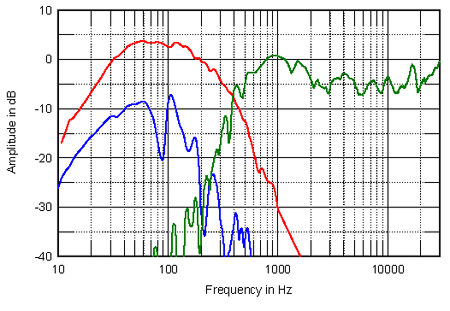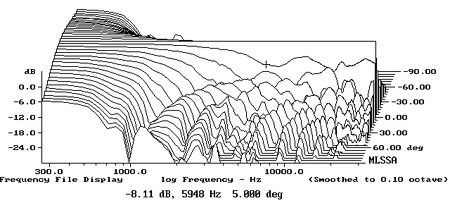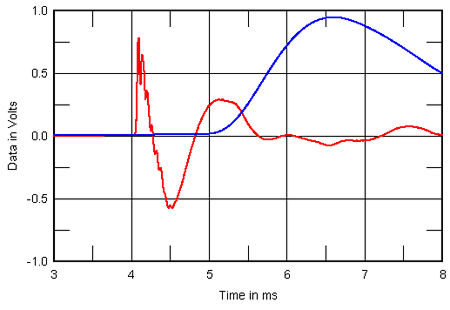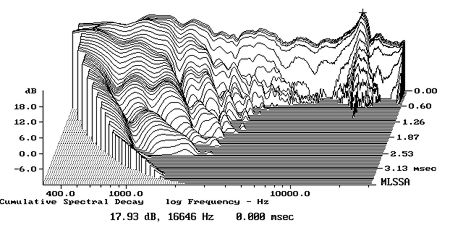The fine distinctions among players in string sections—the sense of many working together nearly perfectly as one—when playing John Barbirolli and the Sinfonia of London's classic performance of Vaughan Williams' Fantasia on a Theme by Thomas Tallis (CD, EMI 5 67264 2) were uncannily present. Logically, the less mass that has to be accelerated, the more rapidly it can be accelerated, and the Ultra Stat is about as close to having no mass as any driver can be. More intimate music, such as Bill Evans' bittersweet, endlessly inventive reharmonizations of "Suicide Is Painless," from You Must Believe in Spring (LP, Warner Bros. HS 3504), showed another side of the Kaya's marvelous resolution. Tiny, fine points of piano and drums filled the far end of the room with natural warmth, and a level of midrange and treble liveness that was tingle-inducing.
The Kaya played big, bold music, such as Hans Zimmer's score for the film Gladiator (CD, Decca 467-094-2), in big, bold, superbly defined spaces. Their resolution of the hall depth on the Vaughan Williams Fantasia was breathtaking, the antiphonally placed players beautifully focused in a space defined with electrifyingly lifelike expansiveness. The depth of the soundstage on "Journey to the Line," from Zimmer's score for The Thin Red Line, was extremely impressive, the big drums booming into the picture from a precisely defined point far away, albeit with less force than is available from the Focal-JMlab Nova Utopia Be's. The Stan Kenton Band's Standards in Silhouette (rainbow-label LP, Capitol ST 1934) was recorded in a cavernous space that the Kayas wrapped lovingly around my room.
Timbral colors benefited from the same serene microresolution as did spatial characteristics. The multitude of fretted instruments used by Ry Cooder in "The Pearls/Tia Juana," from Jazz (LP, Warner Bros. BSK 3197), were superbly individualized. Through the Kaya, sounds that seemed piled atop one another even through excellent speakers were neatly separated. The way the Kaya handled vocal sibilants was a textbook lesson in how to do it right. There was never any additional heat unless it had been recorded in the source material. The inimitable Frank Sinatra was as subtle as life, the wear and tear in his voice just beginning to become apparent, but the command still there in "Follow Me," from Francis A. Meets Edward K. (LP, Reprise FS 1024). If you don't have this wonderful album, you're missing one of life's great treats.
The distinctive quality of the cellos and basses digging in at the beginning of the third movement of Vaughan Williams' Symphony 3, as performed by André Previn and the LSO (UK LP, RCA SER 4659-55), was exceptional—in fact, stringed instruments of all kinds had a uniquely alive quality. The acoustic guitar that introduces Armin van Buuren's "Never Wanted This," from 76 (CD, Ultra L 1168-2), was delightfully delicate and sensitively rendered. The array of acoustic and electric guitars and bouzoukis on Moving Hearts' "Hiroshima Nagasaki Russian Roulette," from Moving Hearts (UK LP, WEA K 58387), rang clear and true.
Transient response was, as should be obvious from the foregoing, phenomenal. The stray-dog bark of Keith Richards' guitar introduction to "Can't You Hear Me Knockin'," from Sticky Fingers (LP, Rolling Stones FC 40488), had the presence and snap of an amplifier sitting in the room with me. Oscar Peterson and Count Basie's The Timekeepers (LP, Pablo 2310-896) presents a different and even more challenging contrast and test. Basie's sparse, wry statements and Peterson's dizzying arabesques demand very different types of articulation for each man's style to be fully realized. The Kaya loved this music, capturing every nuance, foot tap, and hum, and every last bit of the masters' idiosyncrasies and nuances. The leading edge of the acoustic guitar on "Never Wanted This" sounded completely natural. And even with all hell breaking loose around them, Adrian Belew and Robert Fripp's unthinkably complex counterpoint in the first section of the title track of King Crimson's The ConstruKction of Light (CD, Virgin 49361 2) had the calm, centered precision of a Japanese rock garden.
Even given the Kayas' strengths, their imaging stood out as something special. With Francis A. Meets Edward K., Sinatra hung in the air, a vividly life-sized, three-dimensional presence, the Duke Ellington orchestra's sumptuous tones and swinging rhythms surrounding him with equally lush palpability. Anything recorded with any sense of what music actually sounds like came through the Kayas with touchable solidity. Placement precision and boundary definition were the equals of, and on some recordings superior to, the Nova Utopias'.
The panel's dynamics were exceptionally good over all of its range. Its high power-handling capacity and lightning-strike speed allowed it to be driven hard. As panel speakers usually require a little more oomph than their sensitivity specifications suggest, this is a good thing. I could play the Kayas at completely unreasonable loudness levels, and they never started to sound in any way forced or overstressed on anything I hit them with. Your mileage may vary, but I can guarantee that they'll play loud enough to damage your hearing, should you so desire.
I did need to listen on axis or pretty darn close to it—there was a considerable venetian-blind effect off-axis, and way off axis the Kayas sounded just plain weird. Which is why Innersound tells you to set them up the way it does. So there.
Bassic inquiries
With the woofer and panel wired in the same polarity—see later—the Kaya's bass was at first a bit disappointing, given the stellar quality of the electrostatic panel. I often found that I had to readjust the bass and midrange levels from recording to recording. Most often, the bass level was set at 9 or 10 (the range is 0-12), the midrange level between 85 and 87 (the range is 0-99). Even changes of a single increment made a substantial difference in bass balance and the clarity of the crossover range. I never felt that there was an ideal balance between the woofer and the panel—the sound always seeming to be a jot too lean or a dash too full.
The woofer itself did go down low, though without every bit of the panel's wideband dynamic ease. When a lot of large bass instruments were all firing away at once, as in the Gladiator soundtrack, things got a little muddled. Really big bass transients, such as the synth detonation that opens "Sweetest," from Sugar's Double Rainbow (Japanese CD, Toys Factory TFCC-81650), didn't have the impact I would have expected. A 10" woofer is being asked to do a lot of heavy lifting when it's the only bass driver in a system touted as a broadband, reference-quality speaker. It seemed as though the Kaya's bass driver had been voiced to sound just a bit polite and "electrostatic" in character at the "starter" settings suggested by Innersound for the crossover amplifier. Nudging the controls up too far only thickened the sound, though never to an unpleasant level—unless I stood on the gas pedal too hard.
Experiments in polarity
JA suggested, based on his measurements of the Innersound Eros Mk.III, that I try reversing the polarity of the Kayas' electrostatic panels. The result was more than slightly surprising. Previously, for optimum balance, the midrange and bass controls had demanded to be tweaked for each recording. Now, with the polarity flipped, a midbass anomaly that was likely room-related instantly vanished, and the Kayas' performance through the upper midbass and lower midrange dramatically stabilized. I was now able to leave the bass set at 8 and the midrange control at 84, and things always sounded right. More unusual was that the deep bass was now substantially extended and clarified on such powerful synthesizer parts as that on Sugar's "Sweetest" and "Heart and Soul."
I'm stumped as to why this should be the case. Whatever—what had been a bit iffy was now solid and powerful. The longer I think about it, the more probable it seems that the integration between the Kaya panel and woofer outputs and the interaction between both outputs and the room acoustics mean that the optimal polarity will be different in different rooms.
I will report further on these differences in the near future.
Kaya con dios
The Innersound Kaya Reference does many things well, some spectacularly so. The electrostatic panel's transparency, offhand ability to retrieve the tiniest bits of spatial and tonal information, and astoundingly holographic imaging are all extraordinary, as is its way with voices. The Ultra Stat panel is a classic of its kind, and a sterling performer. For 20 thou, I'd still like to hear a bit more clarity in the deepest bass, especially when the going gets heavy; but then, I'm a devoted fan of bass-heavy music.
For those who prefer less difficult material, the Kayas' musicality and versatility in adapting to a variety of system and room configurations will likely outweigh their inability to pressurize a room with quite the same authority as such monsters as the Focal-JMlab Nova Utopia Be. That at long last there's an electrostat hybrid that can be played at house-party volumes without compromising its greatest strengths is something to celebrate.
Sidebar 1: Specifications
Description: Two-way, biamplified hybrid loudspeaker with crossover-amplifier for bass drivers. Electrostatic Panel: 13" by 45". Momentary power-handling capacity: 1000W. Impedance: 4 ohms nominal, 2 ohms at 20kHz. Woofer: 10" paper-cone unit in transmission-line enclosure. Momentary power capacity: 600W. Nominal impedance: 4 ohms. Amplifier-crossover: Crossover: 350Hz, 24dB/octave. Maximum output power: 600Wpc into 4 ohms (24.8dBW). Input impedance: 47k ohms. Output impedance: 0.1 ohm. Distortion: ±0.05% at rated output. Frequency response (without crossover function): 10Hz-80kHz, ±0.1dB. Overall System: Frequency response: 24Hz-27kHz, ±2dB. Sensitivity: 98dB/2.83V/m.
Dimensions: Loudspeaker: 74" (1897mm) H by 16" (410mm) W by 19" (487mm) D. Weight: 116 lbs (52.7kg) net, 141 (64.1) lbs shipping. Crossover-amplifier: 17" (436mm) W by 5.5" (141mm) H by 15" (385mm) D. Weight: 42 lbs (19.1kg) net, 47 lbs (21.4kg) shipping.
Loudspeaker finish: Maple veneer with brushed aluminum trim (loudspeaker); brushed aluminum with blue display panel (crossover-amplifier).
Serial numbers of units reviewed: None present.
Price: $20,000/pair. Approximate number of dealers: 12.
Manufacturer: Innersound, 2400 Central Avenue, Suite L, Boulder, CO 80301. Tel: (720) 210-1925. Fax: (303) 413-1088. Web: www.Innersound.net.
Sidebar 2: Associated Equipment
Analog source: SOTA Cosmos Series III turntable, Graham 2.2 tonearm, Dynavector XV-1S cartridge.
Digital source: Classé Omega SACD/CD player.
Preamplification: Manley Labs Steelhead phono stage, VTL TL-7.5 Reference line stage, McIntosh C200 preamplifier (as line stage).
Power amplifiers: Lamm ML1.2 Reference and McIntosh MC501 monoblocks.
Cables: Phono: Hovland Music Groove 2. Interconnect: Cardas Golden Reference, Nordost Valhalla, Acoustic Zen Silver Reference. Speaker: Cardas Golden Reference, Innersound. AC: Shunyata Anaconda Alpha & Anaconda vX, Siltech Ruby Hill, Wireworld Silver Electra III+.
Accessories: Shunyata Hydra 8 (front end) and Hydra 2 (amps) power distribution & conditioning; Grand Prix Audio Monaco, Ultra Resolution Technologies Bedrock stands; Ganymede isolation footers; Caig Labs Pro Gold; Walker Audio SST silver contact enhancer; Ayre/Cardas IBE system-enhancement CD, Cardas Frequency Sweep & Burn-in LP; Argent Room Lenses, Disc Doctor & LAST Labs record-care products.—Paul Bolin
Sidebar 3: Measurements
The Innersound Kaya was more sensitive than I was expecting, at an estimated 89dB/2.83V/m. However, this is way lower than the specified 98dB. Because the woofer and the electrostatic panel are driven by separate amplifiers, I have shown the impedance graphs for each separately. Fig.1 shows that of the panel. It is generally very high, staying above 50 ohms between 225Hz and 1950Hz. However, it plummets in the high treble, reaching a minimum value of 0.5 ohm at 29kHz, which is probably the series resistance of the speaker cable and the internal wiring. There is also an amplifier-punishing combination of 3.3 ohms impedance and a -79 degrees electrical phase angle at 15kHz; both this and the virtual short circuit at 28kHz will lead to problems with amplifiers incapable of sourcing current into these kinds of loads. In addition, the huge variation in impedance in the audioband will give rise to a massive modification of the speaker's frequency response with any amplifier other than a modern solid-state design with a vanishingly low source impedance. Use a classic tube amplifier and the high frequencies will be missing in action!

Fig.1 Innersound Kaya, electrostatic panel, electrical impedance (solid) and phase (dashed). (2 ohms/vertical div.)
Turning to the woofer bin, its impedance magnitude and phase angle are shown in fig.2. Remember, there is no passive crossover; the rise in magnitude above the midrange is therefore due to the voice-coil inductance. Overall, the impedance stays above 4.5 ohms, meaning that the woofer will be fairly easy to drive. Note the single peak at 46Hz, implying that the woofer acts as if it is in a sealed box. The big, rectangular port at the base of the enclosure appears to be the termination of a true transmission line, not a reflex vent.

Fig.2 Innersound Kaya, woofer, electrical impedance (solid) and phase (dashed). (2 ohms/vertical div.)
The wrinkles in the woofer impedance plot are due to cabinet resonances of various kinds. Because the woofer is driven via an external crossover (footnote 1), the higher-frequency modes are unlikely to be excited. However, I did find resonant modes present on all the surfaces, at 172Hz, 240Hz, 340Hz, and 500Hz. Fig.3, for example, shows a waterfall plot calculated from an accelerometer fastened to the center of the sidewall level with the woofer—a fairly strong ridge of delayed energy can be seen at 172Hz. (The woofer was driven by the crossover-amplifier for this measurement, as it would be for music.)

Fig.3 Innersound Kaya, cumulative spectral-decay plot calculated from the output of an accelerometer fastened to the cabinet's side panel level with the woofer (MLS driving voltage to speaker, 7.55V; measurement bandwidth, 2kHz).
The fairly high frequency of 46Hz for the woofer's box tuning frequency would result in a limited low-frequency extension without any equalization. This is shown by the black trace in fig.4, which is the nearfield response of the woofer driven by a conventional power amplifier. Without a low-pass filter, the response extends up to the 1kHz limit of the graph, while in the bass, the woofer starts slowly rolling off below 120Hz, reaching -6dB at 55Hz. The colored traces show the woofer's nearfield response, but now driven with the Innersound crossover-amplifier. The Midrange control, which sets the woofer level, was set to "90," the Bass control first to "0" (the lowest trace, identical to the response without the crossover), then to all the levels from "1" to "12" (top, colored traces). It can be easily seen that the crossover-amplifier both rolls off the midrange—reaching -12dB at 500Hz—and allows the woofer's bass response to be extended down to -6dB at 20Hz. With the usual boundary reinforcement in a typical room, the Kaya's bass extension will reach 20Hz.

Fig.4 Innersound Kaya, nearfield response of woofer without crossover (black) and with crossover bass control set from "0" to "12" (colored traces).
Fig.5 shows the individual responses of the port (blue trace), woofer (red), and electrostatic panel (green), the latter two traces being composites of the nearfield response at low frequencies and the on-axis farfield response at high frequencies. Actually, the large size of the electrostatic panel means that the microphone is not actually in the farfield when placed at my usual measuring distance of 50", which results in the slight downward tilt in the upper midrange that can be seen in the panel's output. Other than that, the Kaya's on-axis output is fairly smooth and flat. The various peaks below the panel's passband are due to the different drumhead resonances of a tautly stretched diaphragm. The fundamental diaphragm resonance lies at 76Hz, but is effectively suppressed by the crossover. It will be excited by the woofer to some extent, and I could hear it coloring my voice when I spoke close to the panel. (This is what Paul Bolin heard when he rapped the speaker's side cheeks.) I wonder if this contributed to the occasional "muddling" Paul noted in his auditioning.

Fig.5 Innersound Kaya, acoustic crossover on center-of-panel axis at 50", with the nearfield responses of the panel (green), woofer (red), and port (blue), weighted in the ratio of the square roots of the radiating areas.
The crossover to the dynamic woofer takes place at 400Hz, though this will be affected by the setting of the Midrange control. With the Bass set to "12," the LF response extends down to the lowest bass. There is no minimum-motion point, confirming that the woofer doesn't act as if it is reflex-loaded. However, there is some output from the port (blue trace), disturbed by slight peaks at the frequencies of the wrinkles in the impedance traces. These are well down in level, however, and shouldn't affect sound quality.
My usual practice is to show a speaker's farfield response averaged across a 30 degrees horizontal angle centered on the listening axis. I have done this for the Kaya in fig.6, which appears to show a catastrophic lack of treble. However, this is almost entirely due to the fact that a large, flat diaphragm becomes extremely directional in the treble, something that is graphically shown in fig.7, the speaker's lateral radiation pattern. Only the differences between the off- and on-axis responses are shown in this graph. Basically, you need to sit within a couple of degrees of the panel's centerline to get a full measure of high frequencies.

Fig.6 Innersound Kaya, anechoic response on center-of-panel axis at 50", averaged across 30 degrees horizontal window and corrected for microphone response, with the complex sum of the nearfield panel, woofer, and port responses, taking into account acoustic phase and distance from the nominal farfield point, plotted below 300Hz. (Panel connected in inverted polarity.)

Fig.7 Innersound Kaya, lateral response family at 50", normalized to response on center-of-panel axis, from back to front: differences in response 90 degrees-5 degrees off-axis, reference response, differences in response 5 degrees-90 degrees off-axis.
In the vertical plane (fig.8), the Kaya's balance doesn't change significantly with listener height, due to its radiation pattern taking on some of the character of a line source. Both this graph and fig.6 were taken with the polarity of the panel inverted, which gave the best frequency-domain integration of the woofer and panel outputs. A crossover suckout develops at extreme high or low positions in this graph; with the same polarity connection, this suckout develops on the listening axis.

Fig.8 Innersound Kaya, vertical response family at 50", normalized to response on center-of-panel axis, from back to front: differences in response 10 degrees-5 degrees above axis, reference response, differences in response 5 degrees-15 degrees below axis. (Panel connected in inverted polarity.)
To investigate why this should be, I plotted the farfield step responses of the woofer and ELS panel separately in fig.9, with both connected in positive acoustic polarity. The panel's step (red trace) features a coherent right-triangle shape, but with some significant lower-frequency ringing present. The blue trace is the woofer step, and it can be clearly seen that its initial rise away from the time axis is opposed by a negative-going section of the panel step's tail. This correlates with the frequency-domain cancellation in the lower midrange on the listening axis.

Fig.9 Innersound Kaya, step response on center-of-panel axis at 50" of electrostatic panel (red) and woofer (blue), both connected in normal polarity (5ms time window, 30kHz bandwidth).
Inverting the panel's output gives the step response of the complete speaker shown in fig.10: the decay of the panel step now smoothly hands over to the start of the woofer's step, which results in better frequency-domain integration of the two units. Whether this is preferred or not will depend on the listening room's acoustic and the height of the listener's chair. I note, however, that PB preferred the Kaya's midrange presentation with the panel and woofer in opposite polarity. Kaya owners should experiment for themselves.

Fig.10 Innersound Kaya, step response on center-of-panel axis at 50", panel connected in inverted polarity (5ms time window, 30kHz bandwidth).
Finally, fig.11 shows the Kaya's cumulative spectral-decay plot, measured in the farfield. Other than a ridge of delayed energy between 16 and 17kHz that coincides with a response peak, the delay of the impulse is much cleaner than I usually find with panel speakers.

Fig.11 Innersound Kaya, cumulative spectral-decay plot at 50" (0.15ms risetime).
Some of the Innersound Kaya's measured behavior is idiosyncratic, but whether or not this will result in audible problems will depend on how the speaker is set up, and whether or not the partnering amplifier can cope with the difficult load. Certainly, in my own auditioning of the speaker at recent shows, I have been very impressed with the accuracy and stability of the imaging and the clean, well-balanced sound—as long as I sat in the sweet spot!—John Atkinson
Footnote 1: The Kaya's crossover-amplifier is similar to that provided with the Innersound Eros loudspeaker; see www.Stereophile.com/loudspeakerreviews/819 for its measured performance.—John Atkinson


![]()
 Last May, I suspected that my lifelong electrostatic drought had come to an end when I heard the Innersound Kaya Reference system ($20,000/pair) at Home Entertainment 2004 East, in New York. I was instantly taken by their striking looks and their ability to hold up to even my loudest, most bass-heavy J-pop CDs with no strain. Both John Atkinson and I were impressed, and arrangements were promptly made for review samples to be sent along.
Last May, I suspected that my lifelong electrostatic drought had come to an end when I heard the Innersound Kaya Reference system ($20,000/pair) at Home Entertainment 2004 East, in New York. I was instantly taken by their striking looks and their ability to hold up to even my loudest, most bass-heavy J-pop CDs with no strain. Both John Atkinson and I were impressed, and arrangements were promptly made for review samples to be sent along.









